instrument panel BUICK REGAL 1995 Owners Manual
[x] Cancel search | Manufacturer: BUICK, Model Year: 1995, Model line: REGAL, Model: BUICK REGAL 1995Pages: 340, PDF Size: 17.16 MB
Page 21 of 340
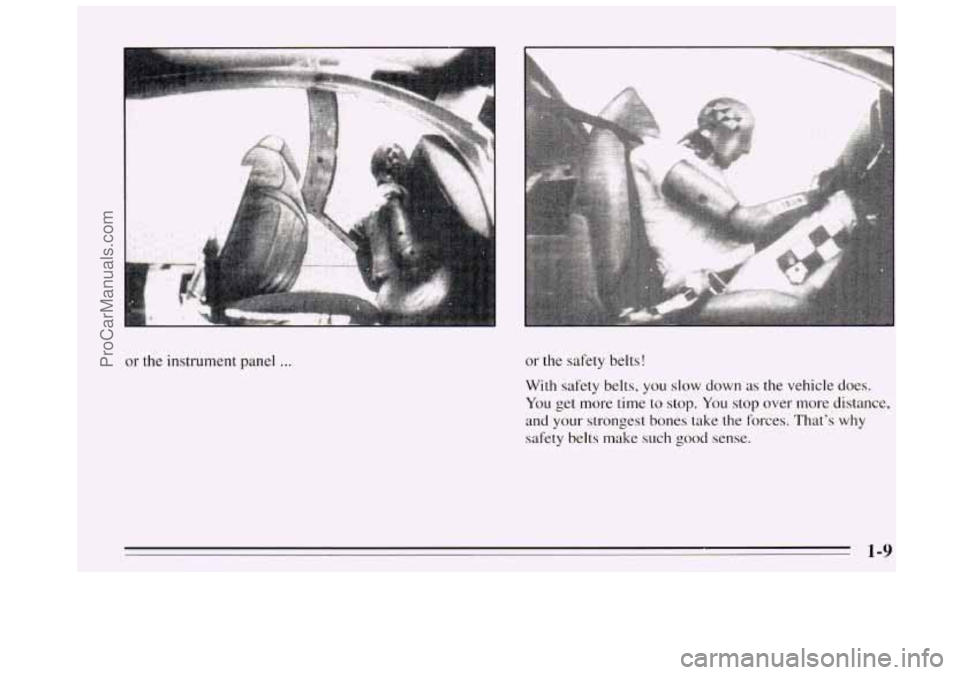
or the instrument panel ... or the safety belts!
With safety belts,
you slow down as the vehicle does.
You get more time to stop. You stop over more distance,
and your strongest bones take the forces. That’s why
safety belts
make such good sense- ,-
1-9
ProCarManuals.com
Page 32 of 340

How the Air Bag System Works
P
Where is the air bag?
The driver’s air bag is in the middle of the steering
wheel. The right front passenger’s air bag
is in the
instrument panel on the passenger’s side.
1-20
ProCarManuals.com
Page 33 of 340
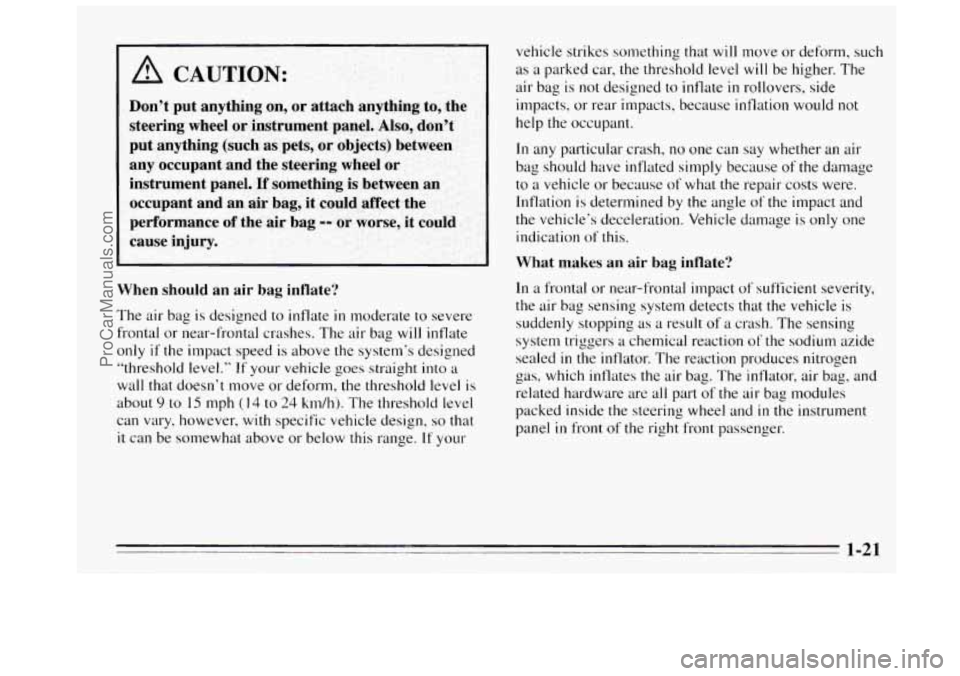
I
I A CAUTION:
vehicle strikes something that will move or deform, such
as a parked car, the threshold level will be higher. The
air bag is not designed to inflate
in rollovers, side
impacts, or rear impacts, because inflation would not
help the occupant.
In any particular crash, no one can say whether an air
bag should have inflated simply because of the damage
to
a vehicle or because of what the repair costs were.
Inflation
is determined by the angle of the impact and
the vehicle’s deceleration. Vehicle damage
is only one
indication
of this.
What makes an air bag inflate?
In a frontal or near-frontal impact of sufficient severity,
the air bag sensing system detects that the vehicle is
suddenly stopping as
a result of a crash. The sensing
system triggers
a chemical reaction of the sodium azide
sealed
in the inflator. The reaction produces nitrogen
gas, which inflates the air bag. The inflator, air bag, and
related hardware are all part of the air bag modules
packed inside
the steering wheel and in the instrument
panel
in front of the right front passenger.
1-21
ProCarManuals.com
Page 34 of 340

How does an air bag restrain?
In moderate to severe frontal or near-frontal collisions,
even belted occupants
can contact the steering wheel or
the instrument panel. The air bag supplements
the
protection provided by safety belts. Air bags distribute
the force of the impact more evenly over the occupant’s
upper body, stopping the occupant more gradually. But
air bags would not help you in many types of collisions,
including rollovers and rear and side impacts, primarily
because an occupant’s motion is not toward the air bag.
Air bags should never be regarded as anything more
than
a supplement to safety belts, and then only in
moderate to severe frontal or near-frontal collisions.
What will you see after an air bag inflates?
After the air bag inflates, it quickly deflates. This occurs
so quickly that some people may not even realize the air
bag inflated. Some components of the air bag module
in
the steering wheel hub for the driver’s air bag, or the
instrument panel for the right front passenger’s bag, will
be
hot for a short time, but the part of the bag that comes
into contact with you
will not be hot to the touch. There
will be some smoke and dust coming from vents
in the
deflated air bags. Air bag inflation will not prevent the
driver from seeing or from being able to steer the
vehicle, nor will
it stop people from leaving the vehicle. In
many crashes severe enough to inflate an air bag,
windshields are broken by vehicle deformation.
Additional windshield breakage may
also occur from the
right front passenger air bag.
The air bags are designed to inflate only once. After
they inflate,
you’ll need some new parts for your air
bag system.
If you don’t get them, the air bag system
won’t be there to help protect you
in another crash.
A
new system will include air bag modules and
possibly other parts. The service manual for your
vehicle covers the need to replace other parts.
1-22
-- -
ProCarManuals.com
Page 35 of 340

a
a
Your vehicle is equipped with a diagnostic module,
which records information about the air bag system.
The module records information about the readiness
of the system, when the sensors are activated and
driver’s safety belt usage at deployment.
Let only qualified technicians work on your
air bag
system. Improper service can mean that your air bag
system won’t work properly. See your dealer for
service.
I NOTICE:
If you damage the cover for the driver’s or the
right front passenger’s air bag, they may not
work properly.
You may have to replace the air
bag module in the steering wheel or both the air
bag module and the instrument panel for the
right front passenger’s air bag.
Do not open or
break the air bag covers.
Servicing Your Air Bag-Equipped Buick
Air bags affect how your Buick should be serviced.
There
are parts of the air bag system in several places
around your vehicle. You don’t want the system
to
inflate while someone is working on your vehicle. Your
Buick dealer and the 1995 Regal Service Manual have
information about servicing your vehicle and the air bag
system.
To purchase a service manual, see “Service
Publications” in the Index.
The air bag system does not need regular maintenance.
I I
1-23
ProCarManuals.com
Page 63 of 340
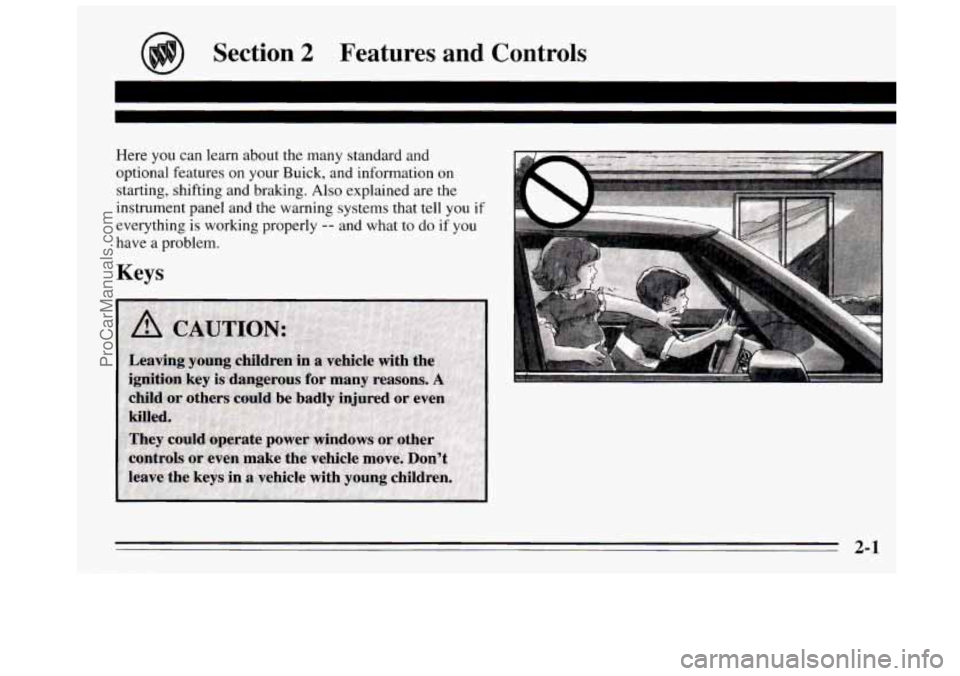
Section 2 Features and Controls
Here you can learn about the many standard and
optional features on your Buick, and information on
starting, shifting and braking.
Also explained are the
instrument panel and the warning systems that
tell you if
everything is working properly -- and what to do if you
have a problem.
Keys
2-1
ProCarManuals.com
Page 66 of 340

Automatic Door Locks
Just close your doors and turn on the ignition. All of the
doors will lock when you move your shift lever out of
PARK
(P) or NEUTRAL (N). All doors will unlock
automatically when the ignition is turned off.
From the inside, push
the lever down to lock the door.
To unlock, push the lever up.
rower Door Locks
Press the power door lock switch to lock or unlock all
doors.
On four-door models,
the rear doors do not have power
door lock switches. The lever on each rear door works
only that door’s lock. It won’t lock or unlock all the
doors. If
someone needs to get out while the vehicle is running,
have that person use the manual or power lock. When the
door
is closed again, it will lock automatically as long as
the shift lever is out
of PARK (P) or NEUTRAL (N) and
the ignition is
on. Note that the door must be opened, then
closed, or the door will not automatically relock.
If you don’t want the doors to unlock automatically
when
you turn the ignition off, you can remove the Lock
Control
fuse in the instrument panel fuse block. See
“Fuses and Circuit Breakers” in the Index.
Leaving Your Vehicle
If you are leaving the vehicle, take your keys, open your
door and set the locks from inside. Then get out and
close
the door.
2-4
ProCarManuals.com
Page 73 of 340

LOCK: Before you put the key into the ignition switch,
the switch is in
LOCK. It’s also the only position in
which you can remove your key. This position locks
your ignition, steering wheel and transaxle. It’s a
theft-deterrent feature.
OFF (B): This position lets you turn off the engine but
still turn the steering wheel. It doesn’t lock the steering
wheel
like LOCK. Use OFF if you must have your
vehicle pushed or towed.
RUN (C): This position is where the key returns after
you start your vehicle. With the engine off,
you can use
RUN to display some
of your warning and indicator
lights.
START (D): This position starts your engine.
A warning chime will sound if you open the driver’s
door when
the ignition is in OFF, LOCK or ACC and
the key is
in the ignition.
NOTICE:
If your key seems stuck in LOCK and you can’t
turn it, be sure it is all the
way in. If it is, then
turn the steering wheel left and right while you
turn the key hard. But turn the key only with
your hand. Using a tool to force it could break
the key or the ignition switch. If none of this
works, then your vehicle needs service.
Starting Your Engine
Engines start differently. The 8th digit of your Vehicle
Identification Number (VIN) shows the code letter
or
number for your engine. You will find the VIN at
the top
left of your instrument panel. (See “Vehicle
Identification Number” in
the Index.) Follow the proper
steps to start
the engine.
Move your shift lever
to PARK (P) or NEUTRAL (N).
Your engine won’t start
in any other position -- that’s a
safety feature. To restart when you’re already moving,
use NEUTRAL
(N) only.
2-11
ProCarManuals.com
Page 88 of 340
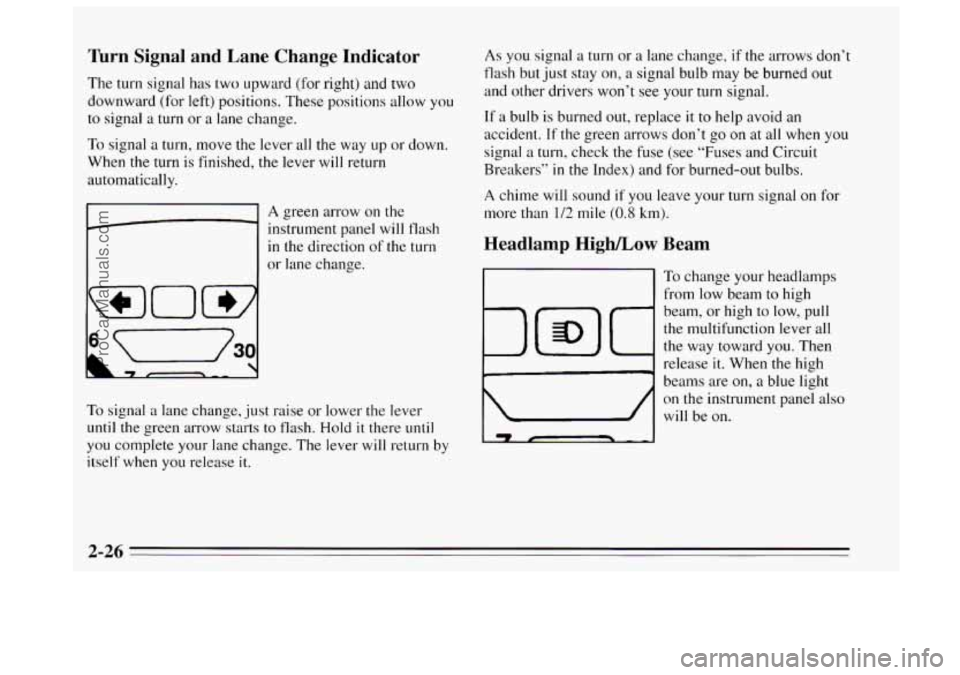
Turn Signal and Lane Change Indicator
The turn signal has two upward (for right) and two
downward (for left) positions. These positions allow you
to signal a turn or a lane change.
To signal
a turn, move the lever all the way up or down.
When
the turn is finished, the lever will return
automatically.
A green arrow on the
instrument panel will flash
in the direction of the turn
or lane change.
To signal a lane change, just raise or lower the lever
until the green arrow starts to flash. Hold it there until
you complete your lane change. The lever will return by
itself when you release it.
As you signal a turn or a lane change, if the arrows don’t
flash but just stay on, a signal bulb may be burned out
and other drivers won’t see
your turn signal.
If a bulb is burned out, replace
it to help avoid an
accident. If the green arrows don’t go on at all
when you
signal a turn, check the fuse (see
“Fuses and Circuit
Breakers”
in the Index) and for burned-out bulbs.
A chime will sound if you leave your turn signal on for
more than 1/2 mile
(0.8 km).
Headlamp High/Low Beam
bmd
To change your headlamps
from low beam to high
beam, or high to low, pull
the multifunction lever all
the way toward you. Then
release
it. When the high
beams are on,
a blue light
on the instrument panel
also
will be on.
2-26
ProCarManuals.com
Page 91 of 340
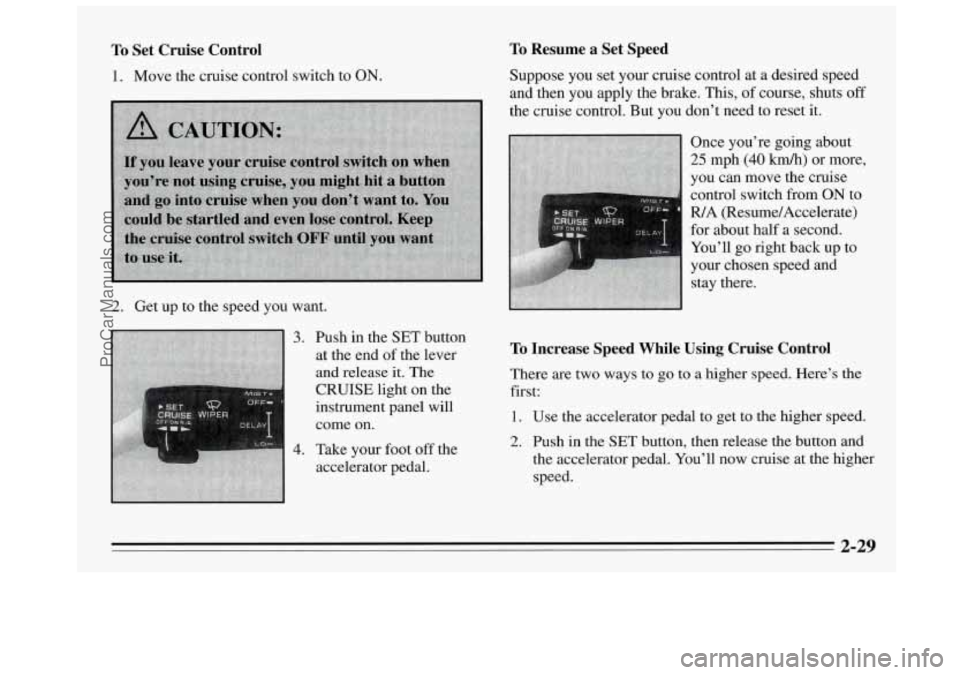
To Set Cruise Control
1. Move the cruise control switch to ON.
2. Get up to the speed you want.
3.
4.
Push
in the SET button
at the end of the lever
and release
it. The
CRUISE light on the
instrument panel will
come on.
Take your foot off the
accelerator pedal.
To Resume a Set Speed
Suppose you set your cruise control at a desired speed
and then you apply the brake. This, of course, shuts
off
the cruise control. But you don’t need to reset it.
Once you’re going about
25 mph (40 km/h) or more,
you can move the cruise
control switch from
ON to
WA (Resume/Accelerate)
for about half
a second.
You’ll go right back up to
your chosen speed and
stay there.
To Increase Speed While Using Cruise Control
There are two ways to go to a higher speed. Here’s the
first:
1.
2.
Use the accelerator pedal to get to the higher speed.
Push in the
SET button, then release the button and
the accelerator pedal. You’ll now cruise at the higher
speed.
2-29
ProCarManuals.com